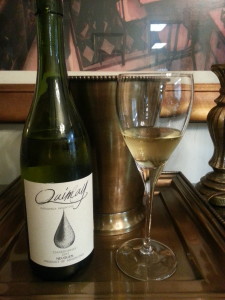According to the label, these grapes were grown in a rugged, desert land in Patagonia, Argentina, that was inhabited for centuries by the fierce Mapuche Indians. The Mapuche had oasis sanctuaries which became holy sites called Quimay or blessed water. Today the vineyards are planted in many of these areas brought to life in a harsh terrain by the Mapuche’s blessed water.
We recently returned from a trip to South America where we tasted many wines from Patagonia, Mendoza, Chile, and even Uruguay. My husband, feeling sentimental about Patagonia, saw this bottle of wine in a local liquor store and picked it up for me. So, I decided to try it and share my thoughts about this chardonnay that doesn’t really taste like a chardonnay.
This wine has a faint scent of ripe pear in the nose. At first taste, the wine seems bright and fresh with lots of acidity. But as it warms, it becomes more complex with a slight lingering finish. This is not an oaky, creamy chardonnay, but it is imminently drinkable and would stand up well to a lot of different foods.
If you’ve been reading some of my recent reviews of Sonoma County wines, you’ll laugh when I tell you the wine was only $3 a bottle. Again, this was not my dream wine, but at $3 a bottle for a generic bottle of white wine, it wouldn’t hurt to keep some around for your next party for your less discriminating white wine drinkers.
